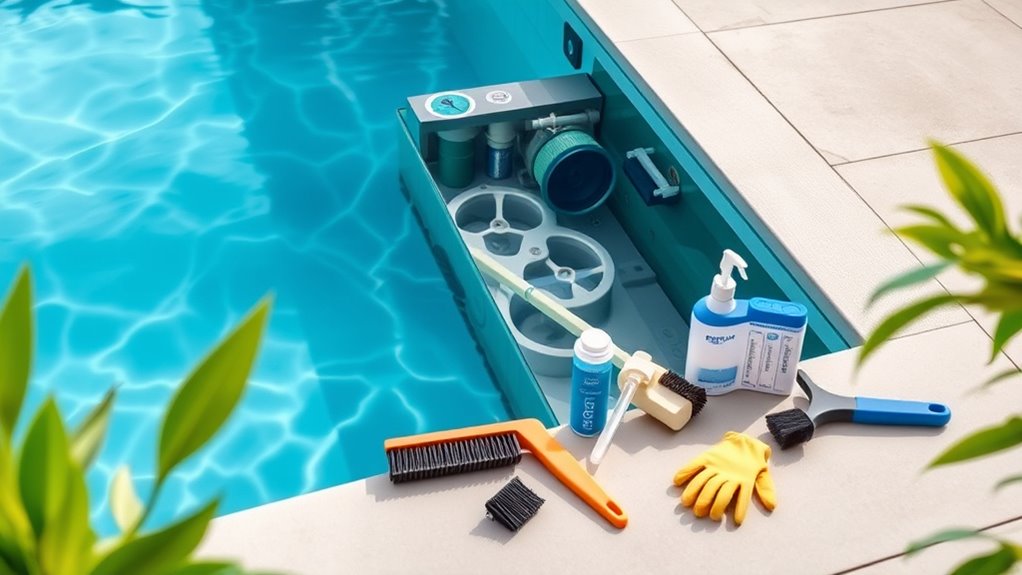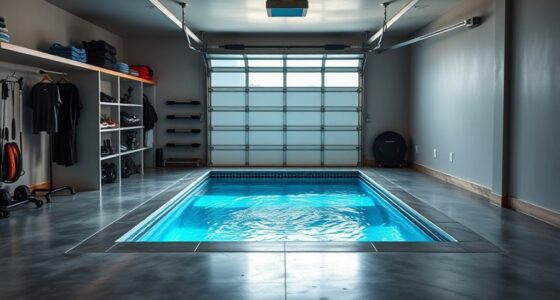To keep your endless pool pristine, perform weekly tasks like testing water chemistry, skimming debris, brushing surfaces, and running the filter for 8-12 hours. Monthly, inspect and clean filters, check equipment for wear, and adjust chemicals as needed. Seasonally, prepare for fall, winter, or spring by removing debris, shutting down or restarting equipment, and balancing water. Following these tips will guarantee your pool stays in top shape—discover more tips below.
Key Takeaways
- Perform weekly tasks like testing water chemistry, skimming debris, brushing surfaces, and running the filter for optimal water quality.
- Conduct monthly inspections and deep cleaning of filters, check equipment for wear, and adjust chemicals as needed.
- Prepare the pool seasonally by removing debris in fall, winterizing equipment, and opening and balancing chemicals in spring.
- Regularly monitor and maintain pH, alkalinity, and sanitizer levels to prevent algae and ensure safe, clear water.
- Protect equipment and incorporate sustainable practices for long-term pool health and environmental responsibility.
Weekly Maintenance Tasks
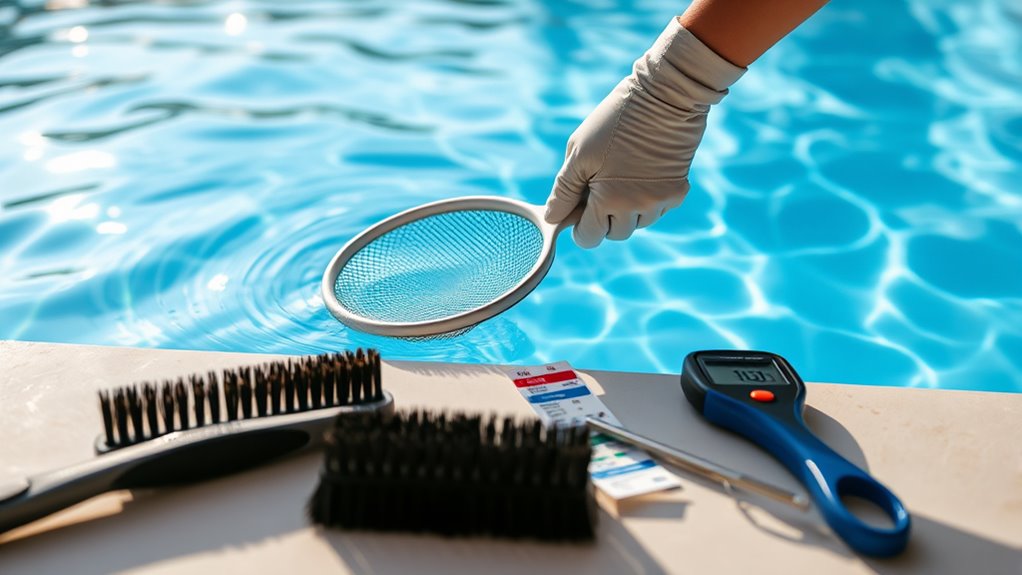
Wondering what needs to be done to keep your pool in top shape? Weekly maintenance tasks are essential for clear, healthy water. First, test your water’s pH, chlorine, and alkalinity levels, and adjust chemicals as needed. This prevents algae growth and keeps the water safe. Next, skim the surface to remove leaves, bugs, and debris that can cloud your pool. Brush the walls and tile to prevent algae buildup and mineral deposits. Check the skimmer and pump baskets, emptying them if they’re full to ensure proper water flow. Run your pool filter for at least 8-12 hours to circulate and clean the water effectively. Staying consistent with these tasks helps maintain water quality and reduces the need for more extensive cleaning later.
Monthly Maintenance Tasks
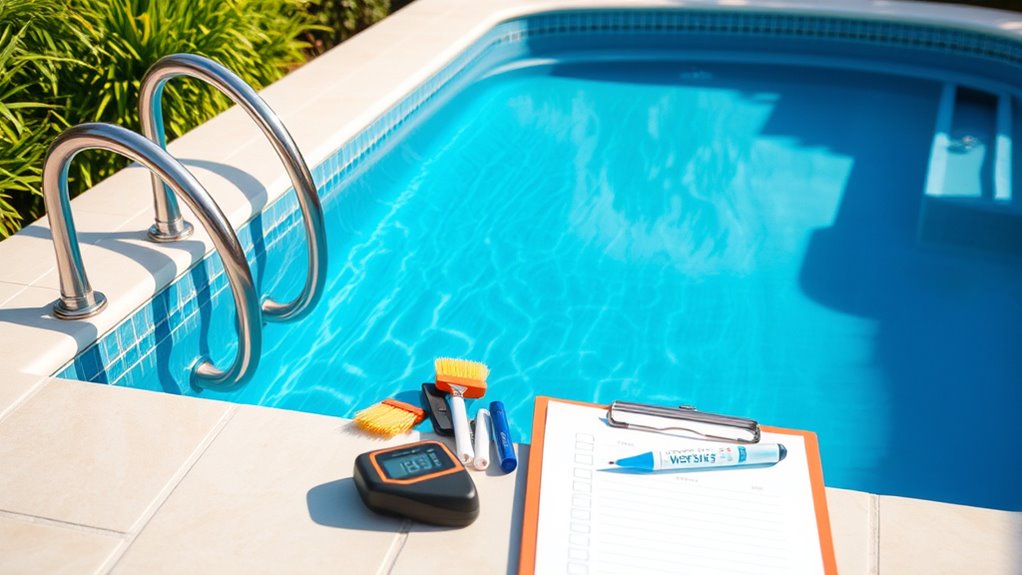
Once a month, you should perform more in-depth maintenance to keep your pool running smoothly. This includes checking chemical levels, inspecting equipment, and cleaning filters thoroughly. Regularly testing your water ensures proper pH, alkalinity, and sanitizer levels, preventing issues down the line. Additionally, examine your pump, heater, and other components for any signs of wear or leaks. Cleaning your filter more deeply helps maintain ideal water flow. Use the table below as a quick reference for essential monthly tasks:
| Task | Equipment/Area | Notes |
|---|---|---|
| Test water chemistry | Test strips or kit | Adjust chemicals as needed |
| Inspect and clean filter | Filter system | Remove debris and rinse |
| Check equipment operation | Pump, heater, jets | Look for leaks or malfunctions |
| Monitor filter efficiency | Filter system | Ensure proper water flow and cleaning |
Seasonal Maintenance Tasks
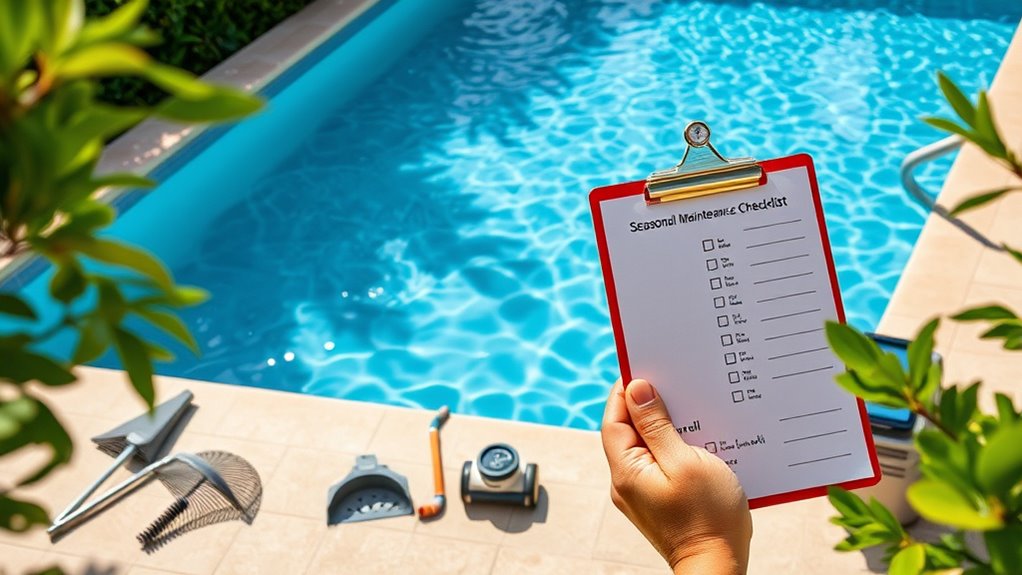
After completing your monthly maintenance tasks, shifting focus to seasonal care helps guarantee your pool remains in top condition year-round. As seasons change, you need to prepare your pool for the upcoming weather. In fall, clean out debris, lower the water level if necessary, and add winterizing chemicals to prevent algae growth. Before winter, ensure your pool’s equipment is properly shut down and protected from freezing temperatures. In spring, remove any winter covers carefully, inspect and start your equipment, and balance the water chemistry. Conduct a thorough cleaning of the entire pool area, check for damage, and replace worn parts. Additionally, understanding the importance of sustainable pool maintenance can help reduce your environmental impact. These seasonal tasks help extend your pool’s lifespan and make certain it’s ready for use when the weather warms up again.
Frequently Asked Questions
How Do I Troubleshoot Common Pool Equipment Malfunctions?
To troubleshoot common pool equipment malfunctions, start by inspecting the power supply and ensuring switches are on. Check for clogged filters or debris blocking pumps. Listen for unusual noises, which can indicate motor issues. Verify that valves are set correctly and that the water level is adequate. If the heater isn’t working, verify the thermostat settings. Regularly cleaning and inspecting equipment helps prevent many problems before they start.
What Safety Precautions Should I Follow During Maintenance?
Sure, safety first—because who doesn’t love a good shock or a slip? You should always turn off power before maintenance, wear protective gloves and goggles, and avoid working alone. Keep your work area dry, and handle chemicals carefully. Remember, rushing can lead to accidents, so stay attentive. Following these precautions guarantees your maintenance is safe, effective, and keeps you swimming happily rather than dealing with avoidable mishaps.
Can I Use Generic Chemicals Instead of Branded Products?
You can use generic chemicals, but you should be cautious. Make sure they meet safety standards and are compatible with your pool’s materials. Cheaper or untested products might not work as well or could damage your pool’s components. Always read labels carefully and follow the manufacturer’s instructions. If you’re unsure, consult your pool’s manual or a professional to avoid potential problems and keep your pool safe and clean.
How Do I Prevent Algae Growth in My Endless Pool?
To prevent algae growth in your endless pool, you should regularly test and balance your water chemistry, especially pH and sanitizer levels. Keep your pool clean by skimming debris and brushing the surfaces weekly. Use a good algaecide as a preventive measure, especially during warm months. Run your pool’s filtration system daily for at least 8-12 hours, and shock the water periodically to keep algae at bay.
What Signs Indicate a Need for Professional Repairs?
Did you know that 60% of pool owners delay repairs until issues worsen? If your pool’s equipment makes unusual noises, the water becomes murky despite filtering, or the heater stops working unexpectedly, it’s time to call a professional. These signs indicate underlying problems that could worsen without expert attention. Addressing repairs early not only saves money but also keeps your pool safe and enjoyable.
Conclusion
Keeping your endless pool in top shape is like tending a garden—you need regular care to see it flourish. By sticking to these weekly, monthly, and seasonal checklists, you’ll guarantee your pool stays clean, safe, and inviting all year round. Think of each task as watering a plant; neglecting it can lead to bigger problems down the line. Stay proactive, and your endless pool will be your invigorating retreat for years to come.
